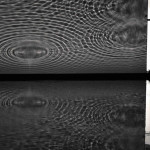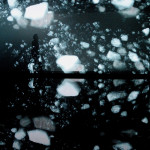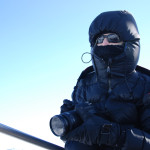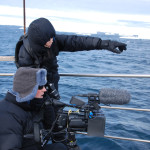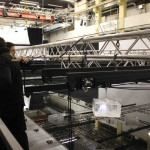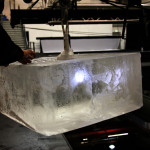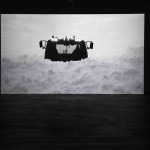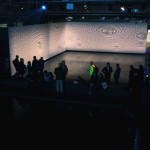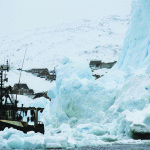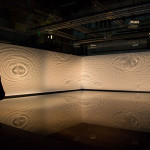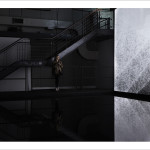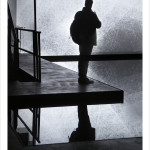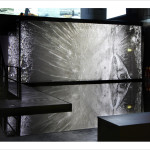OUT OF ICE – The secret language of ice
Título: OUT OF ICE – The secret language of ice
Autora: Elizabeth Olgivie
I’m an environmental artist and I create experiences for my public, rather than images. I’m aiming to open up my public’s perception and understanding of how our environment functions. The work I do seeks to point to issues right at the top of the global agenda and involves highlighting the world’s most challenging problems ——–the impact of climate change and the threat to one of our most precious natural resources —–WATER and ICE
———-My work is a fusion of art architecture and science—— and water is both the medium and subject in my work. I’m endeavouring to create an experience of seeing, drawing people in through the senses and encouraging them to consider water’s worth—- to marvel at its visual effect—–and to appreciate its universal and sustaining properties.
MY RESEARCH over the last four years lead to a major site-specific exhibition and conference in the research-oriented environment of London’s P3 last year.
I’ve always followed my work and in recent years it has led me into the even more remarkable world of water in a solid state, —— ICE, —- as well as issues worldwide brought about by its melting……..
Ice has formed our environment and continues to do so. Its presence is key to the future of our planet, but HOW we know about ice hasn’t been so readily explored. It’s in ice that the roots of our existence are found and where, underneath the ice, our uncharted history lies. My on-going project proposes an investigation into ways of reading and understanding ice——–and its place in the living whole.
While working on the project during recent years and collaborating with Inuit and local residents in Northern Greenland the Arctic environment and its people have cast a very strong spell over me. Arctic residents’ unique READING OF ICE has long been recognized and remains the pillar of their identity and resilience and their most prized intellectual treasure. With their guidance over time, I’m gradually gaining knowledge of ice — its physical properties and character, and ——its important role in the living history of Arctic peoples. In Ilulissat, where I base myself, winter ice enables ice-hunting, fishing and dog-sledding, all of which are highly significant culturally, while summer water allows fishing and hunting from boats. Such an environment calls attention to how materials shift from one state to another- ice-becoming-water, water-becoming-ice.
Mezzanine Ambika P3 Main Entrance
Portal to OUT OF ICE
A large freestanding wall displays large projection of ice wall filmed at the Greenlandic Icecap and revealing timeless ice strata. This almost still, eternal image of the icewall holds its information, its secret language. The projection is viewed on both sides of wall, both very close to public as they enter space and from a distance.
Portal also displays a series of films of the human perspective of climate change in the form of 4 projected films of Inuit’s deep and sustaining relationships with ice. Footage captures Inuit bond with their environment, its extremities, stillness, poetry and concerns with much of dialogue in Greenlandic. This footage includes Inuit explorers will be filmed discussing their projects, a skipper while sailing among ice floes, a halibut fisherman filmed in his tiny boat among the icescape and a young Inuit in his inaccessible district communicating the significance of ice to life there. He recounts a traditional Inuit story reflecting Inuit deep respect for nature.
There is a further projected film on a freestanding wall at far end of mezzanine and shot among the icefloes of the vast Sermeq Kujalleq Glacier, Ilulissat, North West Greenland.
Main Gallery Ambika P3
From the entrance portraying this lived human perspective on climate change and ice itself, the public descends, apparently into a reflective pool, and into the massive construction of bays, minimal pools and viewing decks with two pools 11-12m across. The constructions form the basis of an immersive visual narrative using water, ice, light, and projections, occupying the remaining floor space;
The public moves through the installation via decks, some of them broad to allow reflective zones with benches and providing contemplative spaces;
A section of the installation, magnifying ice crystals and other real-time ice processes and film projections, pre-produced in studio, of ice/water transition, revealing seemingly simple ice processes in all their complexity, are reflected in a still pool. And in a digital film made by Tom DeMajo who interprets the film of melting ice but through using node data portrays the reverse, with ice crystals forming, the project looks optimistically to the future but also expressing a sense of urgency;
Sculptural forms of slow melting ice animate the surface of the other large pool with minimal drops of water, and enlivening it when larger chunks of ice fall into pool. Details of water surface during this ice cycle will create real-time panoramas projected upon surrounding walls by means of theatre lights directed at water’s surface thus using physics’ principles;
Elements of the surrounding architecture reflected in this still pool add to the sense of space and depth in every sense.
Side Galleries Ambika P3
8 large photo works of various ice details, photographed in Greenland and Alaska and 8 ice related text works are displayed in this space;
A film of Lake Ellsworth Exploration Logistics edited by Elizabeth Ogilvie and Rob Page from film clips shot by Pete Bucktrout of British Antarctic Survey, is accompanied by a British Antarctic Survey documentary film by Pete Bucktrout of interviews with Professor Martin Siegert, principle investigator of the Lake Ellsworth consortium.
Credits
Conception: Elizabeth Ogilvie
Technical Director: John Robb
Technical & Creative Manager: Peter Boott
Filmmaker, editor, Schedule D: Rob Page
Designers: Astrid Johnston and Tim Bremner
Sound artist and director: Tom De Majo
Artist: Sandy Annan
Arts PR: Janette Scott
PR: Alison Wright
Artists: Jake Bee, Rob St John and Katie Fowlie,
Collaborators: Professor Martin Siegert, Professor Tim Ingold, Dr Jo Vergunst, Assistant Professor Suna Christensen

